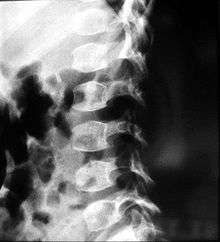Spondyloepiphyseal dysplasia congenita
Spondyloepiphyseal dysplasia congenita (abbreviated to SED more often than SDC) is a rare disorder of bone growth that results in dwarfism,[1] characteristic skeletal abnormalities, and occasionally problems with vision and hearing. The name of the condition indicates that it affects the bones of the spine (spondylo-) and the ends of bones (epiphyses), and that it is present from birth (congenital). The signs and symptoms of spondyloepiphyseal dysplasia congenita are similar to, but milder than, the related skeletal disorders achondrogenesis type 2 and hypochondrogenesis. Spondyloepiphyseal dysplasia congenita is a subtype of collagenopathy, types II and XI.
| Spondyloepiphyseal dysplasia congenita | |
|---|---|
| A 61⁄2-year-old male with spondyloepiphyseal dysplasia congenita. Short stature, disproportionately short trunk, and kyphoscoliosis. | |
| Specialty | Medical genetics |
Presentation
People with spondyloepiphyseal dysplasia are short-statured from birth, with a very short trunk and neck and shortened limbs. Their hands and feet, however, are usually average-sized. This type of dwarfism is characterized by a normal spinal column length relative to the femur bone. Adult height ranges from 0.9 meters (35 inches) to just over 1.4 meters (55 inches). Curvature of the spine (such as kyphoscoliosis and lordosis) progresses during childhood and can cause problems with breathing. Changes in the spinal bones (vertebrae) in the neck may also increase the risk of spinal cord damage. Other skeletal signs include flattened vertebrae (platyspondyly), a hip joint deformity in which the upper leg bones turn inward (coxa vara), and an inward- and downward-turning foot (called clubfoot). Decreased joint mobility and arthritis often develop early in life. Medical texts often state a mild and variable change to facial features, including cheekbones close to the nose appearing flattened, although this appears to be unfounded. Some infants are born with an opening in the roof of the mouth, which is called a cleft palate. Severe nearsightedness (high myopia) is sometimes present, as are other eye problems that can affect vision such as detached retinas. About one-quarter of people with this condition have mild to moderate hearing loss.
Causes

Spondyloepiphyseal dysplasia congenita is one of a spectrum of skeletal disorders caused by mutations in the COL2A1 gene. [2]The protein made by this gene forms type II collagen, a molecule found mostly in cartilage and in the clear gel that fills the eyeball (the vitreous). Type II collagen is essential for the normal development of bones and other connective tissues. Mutations in the COL2A1 gene interfere with the assembly of type II collagen molecules, which prevents bones from developing properly and causes the signs and symptoms of this condition.
Spondyloepiphyseal dysplasia congenita is inherited in an autosomal dominant pattern, which means one copy of the altered gene is sufficient to cause the disorder.
Diagnosis
Diagnostic evaluation usually begins with a thorough medical history and physical examination of the child. At Children’s Hospital of Philadelphia (CHOP), clinical experts use a variety of diagnostic tests to diagnose SEDc and possible complications, including:
X-rays, which produce images of bones. Magnetic resonance imaging (MRI), which uses a combination of large magnets, radiofrequencies and a computer to produce detailed images of organs and structures within the body. Genetic testing, in which a sample of your child’s saliva or blood is used to identify your child’s DNA. Hip arthrography, which uses X-rays and dye injected into the joint to show the soft tissues (ligaments, tendons, cartilage and muscles) of the joint. EOS imaging, an imaging technology that creates 3-dimensional models from two planar images. Unlike a CT scan, EOS images are taken while the child is in an upright or standing position, enabling improved diagnosis due to weight-bearing positioning. Vision and hearing tests, which assess eye and ear function levels. Pulmonary function tests, which test how well the lungs are working.
Treatment
Treatment for SEDc varies because the condition affects several body systems, and each child’s case is different. Some children will only require careful monitoring. Others will need non-surgical or surgical treatments to address specific aspects of their condition.
Many children with SEDc are also diagnosed with a variety of orthopaedic conditions including: scoliosis, coxa vara, foot anomalies and joint problems. In many cases, these conditions only become evident — or problematic — as your child grows.
Depending on the child’s needs, specialists from the Spine Program, Hip Disorders Program, and Leg and Foot Program will treat your child’s orthopaedic and musculoskeletal issues.
Children with other effects of SEDc will be examined and treated by CHOP specialists in genetics, gastroenterology, general surgery, neurology, ophthalmology (eye), otolaryngology (ear, nose and throat) and plastic surgery.
For effects of SEDc, treatment may include:
Bracing and/or surgery for spine issues Bracing and/or surgery for hip disorders Bracing and/or surgery for neck instability Bracing and/or surgery for knee instability and foot anomalies Staged reconstructive surgery for craniofacial disorders Glasses for vision problems. Hearing aids for hearing issues; tubes to reduce ear infections Medication or pain relievers for joint pain Physical therapy to help the child remain limber
Notable cases

Actors Warwick Davis's, Danny Woodburn's, and Mark Povinelli's dwarfism has been attributed to spondyloepiphyseal dysplasia congenita. The condition of late actor Michael Dunn has been attributed to spondyloepiphyseal dysplasia, type unspecified. Mexican actress and comedian Selene Luna may have it as well.
Jennifer Arnold and Bill Klein from the TV series The Little Couple both have spondyloepiphyseal dysplasia as well.
References
- "Spondyloepiphyseal dysplasia congenita | Genetic and Rare Diseases Information Center (GARD) – an NCATS Program". rarediseases.info.nih.gov. Retrieved 2 June 2019.
- Reference, Genetics Home. "Spondyloepiphyseal dysplasia congenita". Genetics Home Reference. Retrieved 3 June 2019.
- Spranger: Bone Dysplasias, Urban & Fischer 2002, ISBN 3-437-21430-6
Further reading
External links
| Classification | |
|---|---|
| External resources |